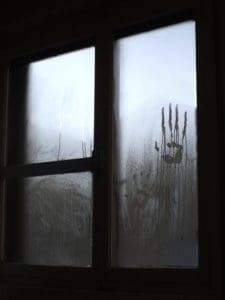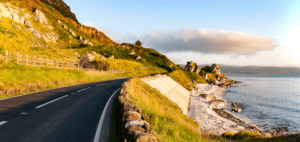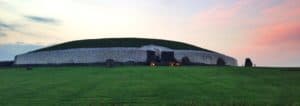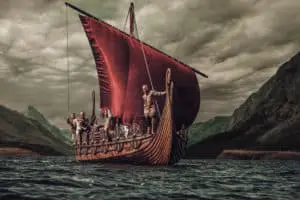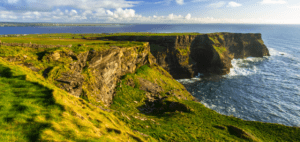The Burren: A Lunar Landscape Rich in Folklore and Natural Wonder
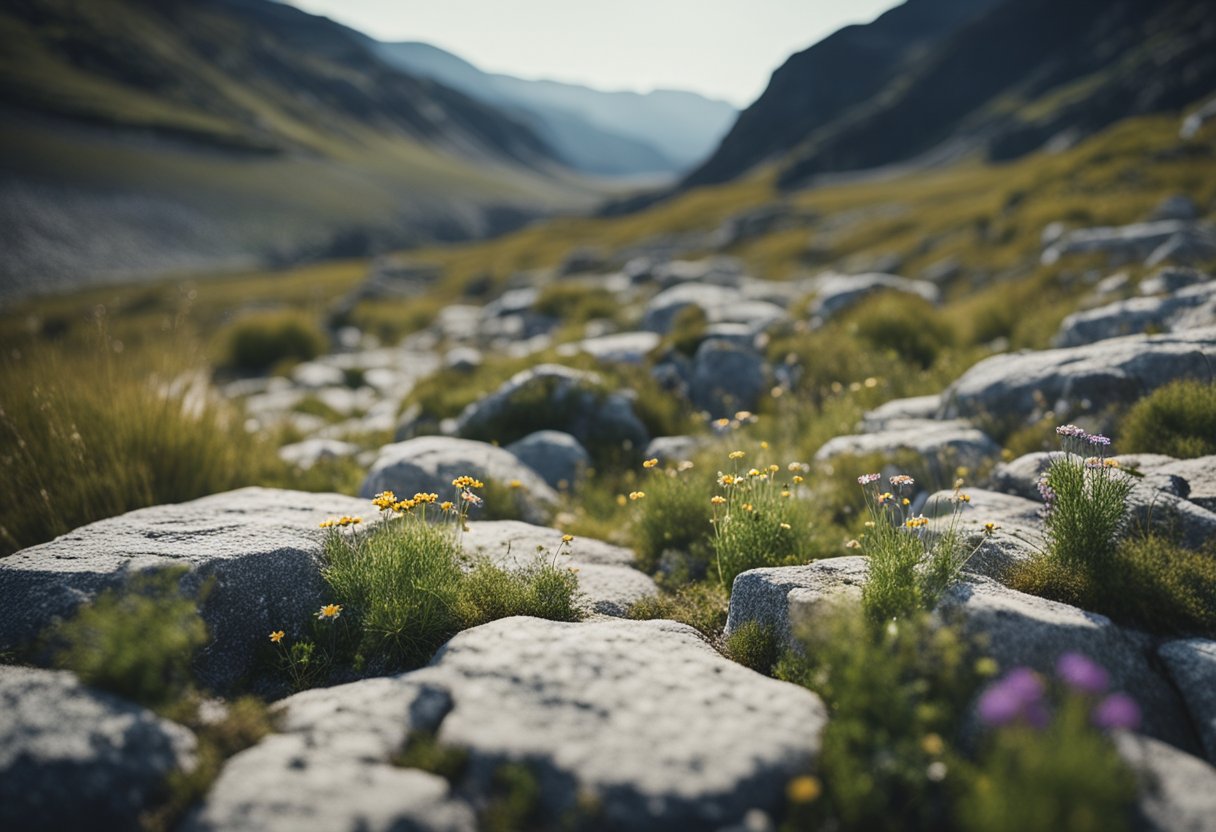
Updated On: March 28, 2024 by Eman Sameh
Nestled in County Clare on Ireland’s wild Atlantic coast, The Burren captivates visitors with its otherworldly appearance, often likened to a lunar landscape due to its vast expanses of limestone pavements. This unique environment, a product of millions of years of geological evolution, stretches over 250 square kilometres, presenting an area rich in natural beauty and steeped in millennia of history. The karst topography, with its deep crevices and weathered rocks, provides a surreal backdrop that’s not only an ecological wonder but also a canvas for the rich tapestry of Irish folklore.
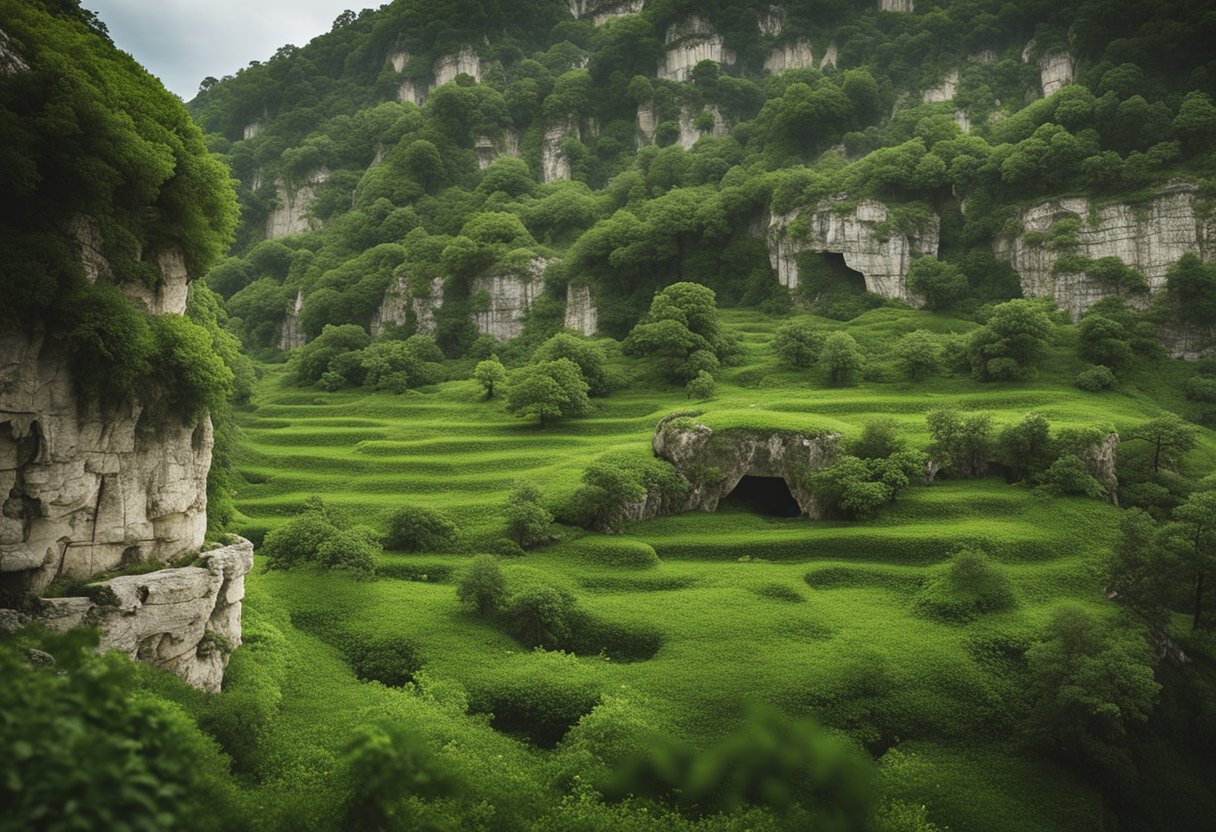
Our exploration of The Burren reveals a place that’s more than just a visual marvel; it’s an intersection of culture and biodiversity unlike any other. While this might seem a stark and barren wasteland at first glance, the limestone fissures hide an astonishing variety of flora including Arctic, Alpine, and Mediterranean plants coexisting unusually side by side. Alongside its ecological significance, The Burren bears the marks of ancient civilisations with megalithic tombs, castles, and monastic sites, threading a story through time that’s as captivating as the landscape itself. Every rock and plant in The Burren is a page from history, every path an invitation to uncover the many layers of Irish heritage and the ongoing efforts to preserve this irreplaceable treasure for future generations.
The Geology of the Burren
Renowned for its unique geology, the Burren presents a karst landscape that captivates geologists and nature enthusiasts alike. Dominated by limestone, this region in County Clare offers a rare glimpse into ancient geological processes.
Limestone Pavement
At the heart of the Burren’s geological marvel lies the limestone pavement. A vast expanse of exposed limestone bedrock, this pavement is a product of numerous freeze-thaw cycles that fractured the rock and created a distinctive, clint-and-gryke topography. Shaped by glacial activity and water erosion over millennia, these pavements are both rugged and delicate, hosting a range of unique flora adapted to this stark environment.
Each block of limestone, known as a ‘clint,’ is isolated by deep fissures called ‘grykes,’ which were formed by the slight dissolution of the limestone by rainwater — a process integral to the development of a karst landscape. The pure calcium carbonate that makes up the limestone led to the preservation of myriad fossils, granting us insights into ancient marine life, now immortalised in stone.
Our journey through the Burren is a venture through time, with the exposed bedrock beneath our feet narrating a history stretching back over 300 million years. Sections of this limestone plateau are smoothed by ancient glaciers, while others are etched with the evidence of erosive forces at work. The limestone’s journey from marine sediment to towering pavement attests to the Earth’s dynamic history.
The Burren’s geology, specifically its limestone pavement, is not just a foundation for unique ecosystems but also a canvas for the story of our planet’s past, preserved within the stone. Our exploration through these pavements reveals a landscape that is a testament to the power of natural processes in sculpting some of the most remarkable geological features found in Ireland.
Historical Context
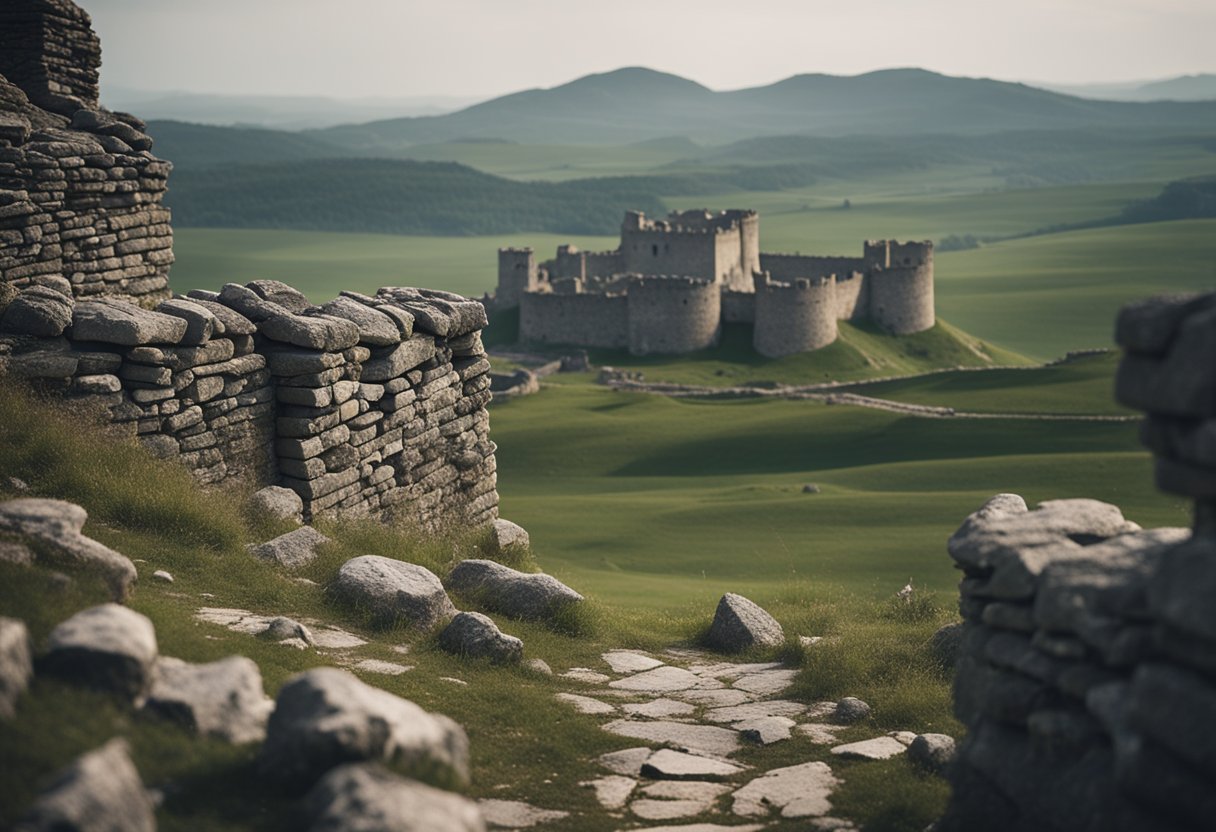
In traversing the historical landscape of The Burren, we are stepping on grounds that echo the early chapters of human history. This limestone region not only captivates with its moon-like appearance but also with its wealth of archaeological sites and ancient edifices.
Ancient Monuments
Our land holds deep historical significance, with The Burren being home to over 500 ring forts and dolmens, testimony to the ingenuity of early inhabitants. Prominently, the Poulnabrone dolmen stands as an iconic Neolithic monument dating back to 2500 BC. This portal tomb signifies the sophistication achieved during the Bronze Age, serving as a burial place for the community. The stark limestone pavements and glacial-era rocks frame these historical treasures, rendering The Burren a mesmerising historical snapshot.
Historical Settlements
Beyond these ancient structures, The Burren’s past is also chronicled through the historical evidence of settlements. It is a landscape that has experienced continuous human habitation since the Stone Age. This is visible in the remnants of the earliest agricultural communities to medieval ring forts. They provide us a narrative about our ancestors’ way of life and social organisation. These archaeological sites across The Burren offer us an invaluable connection to our forebears, revealing a complex history etched into the very soil of this unique ecological and geological wonder.
Burren Flora and Fauna
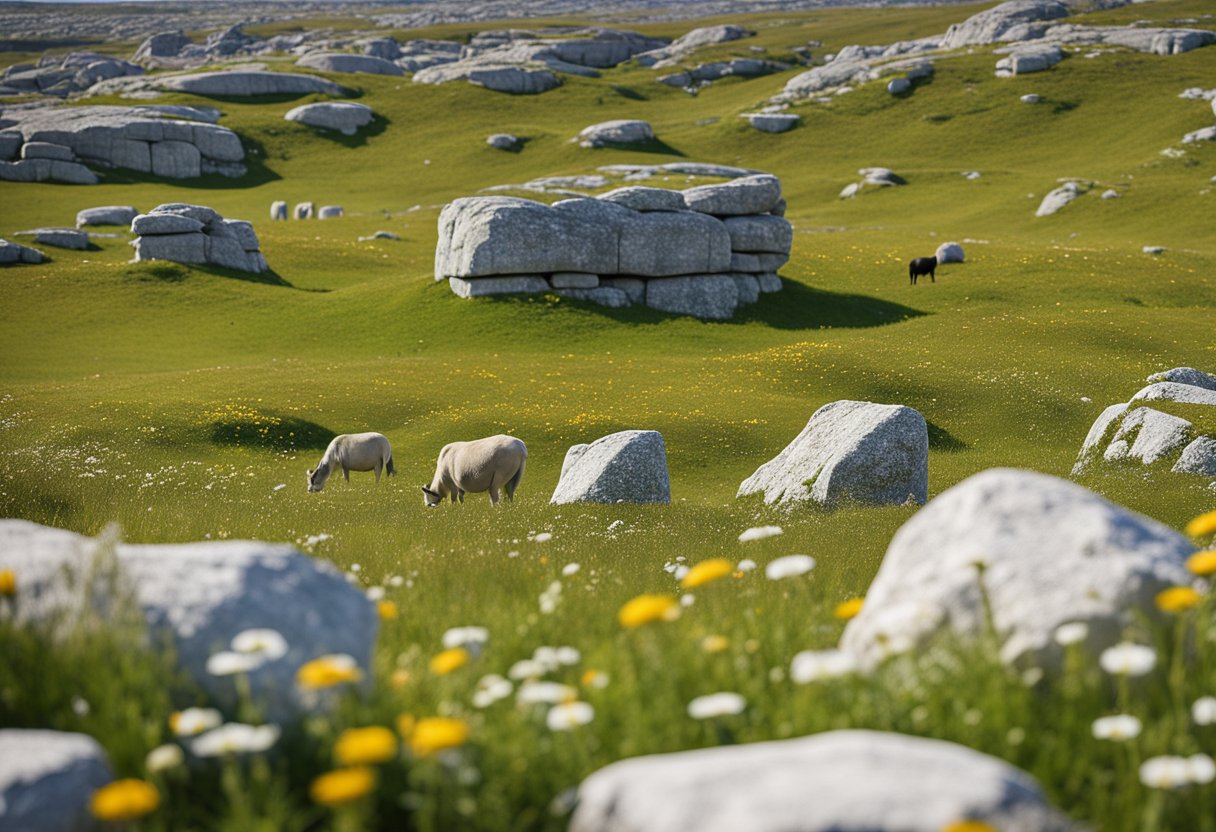
The Burren hosts an exceptional variety of plant and animal life, thriving in a landscape where the line between myth and botany often blurs. Here, the stark beauty of the karst terrain houses both alpine and Mediterranean plant species, while a multitude of animals find sanctuary among its limestone fissures.
Unique Plant Life
The Burren prides itself on an extraordinary botanic composition; its limestone pavements foster a mixture of plant life that is virtually unparalleled. Among the craggy rocks sprout native Irish wildflowers alongside rare orchids that one typically associates with continental climates. The array of over 70 different types of orchids is particularly notable. The juxtaposition of arctic-alpine plants like Dryas octopetala (Mountain Avens) beside such Mediterranean species as Orchidaceae (orchids) and other wildflowers, bolsters the region’s reputation as an exceptional centre of botanical diversity.
- Arctic-Alpine Plants: Present due to the region’s cool micro-climates.
- Mediterranean Species: Thriving in micro-climates that mirror their native habitats.
This blend of plant species with varying geographical origins bestows the Burren with its unique biodiversity, making it a fascinating study for botanists and a spectacular visual feast for visitors.
Animal Habitats
The fauna in the Burren is as diverse and specialised as its flora. The rugged landscape serves as home to both common and protected species. Wild goats navigate the terrain with ease, reminiscent of their ancient ancestors that roamed these lands. Foxes are commonplace within the Burren, adept at surviving in both the dense hazel scrub and the open limestone pavements. The skies above often play host to the powerful peregrine falcon, a bird of prey that nests high on rocky outcrops within the national park.
- Mammals: Including goats and foxes, adapted to the terrain.
- Birds of Prey: Peregrine falcons are a highlight, showcasing the area’s rich ecosystem.
The efforts to preserve the habitats of such creatures are key to maintaining the Burren’s rich tapestry of life. Our reverence for this landscape reflects our belief in the vital importance of conserving such natural heritage.
Cultural Heritage
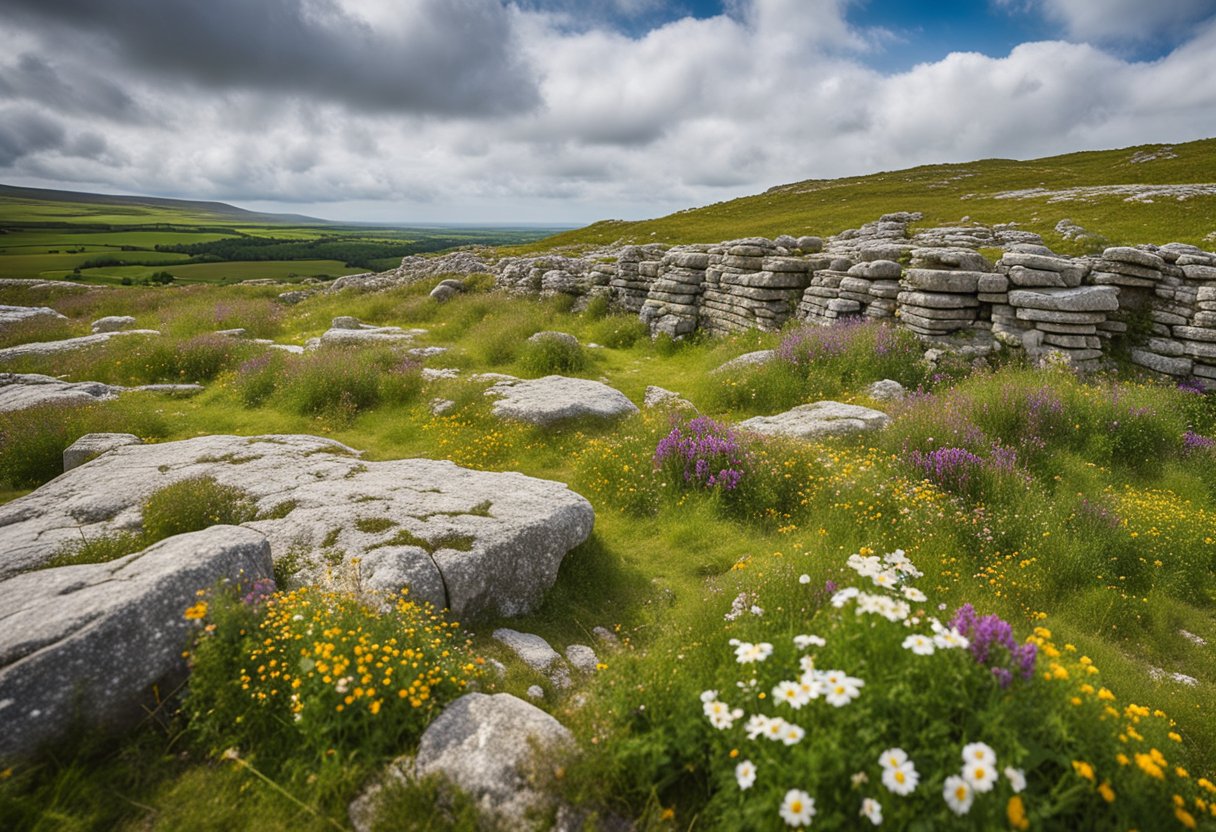
The Burren, with its stark beauty and rolling limestone landscapes, is not only a geological marvel but also a tapestry woven with rich cultural threads. Here, centuries-old local traditions blend with a living history reflected in the Irish language and folklore, making the area a heartland of Irish culture.
Local Traditions
Lisdoonvarna and Kilfenora stand as vibrant custodians of the Burren’s time-honoured traditions. In these communities, traditional Irish music thrives, with sessions held in local pubs that draw in both locals and visitors. The area is also renowned for hosting the Lisdoonvarna Matchmaking Festival, uniting the old tradition of matchmaking with music and dance. Throughout the Burren, old customs continue to be celebrated and passed down through the generations, reflecting the local way of life that has persisted into the 21st century.
- Annual Festivals: The region’s calendar is dotted with festivals celebrating everything from traditional music to local food.
- Craftsmanship: Artisanal crafts such as basket weaving and stone masonry preserve the Burren’s artistic heritage.
Irish Language and Folklore
The Irish language, an emblem of national identity, is cherished and spoken here, acting as a vessel for the stories rooted in this landscape. Our village names, local sayings, and the tales we share are steeped in the essence of Irish heritage. During the 20th century, folklore and the spoken word have played pivotal roles in preserving our history and culture, especially in areas like the Burren, which are rich in myths and fabled histories. Irish folklore is not just a relic of the past; it lives on, colouring our understanding of the land and connecting us to our ancestors through every recounted tale and passed-down legend.
- Kilfenora: As an historical seat of the diocese and a hub for Ceilidh music, it contributes significantly to the Burren’s oral traditions.
- Mythology: Local legends and myths, rich with faeries and ancient heroes, embody the spirit of the Burren and illustrate our unique worldview.
Natural Attractions
The Burren presents an otherworldly environment where its unique geology has shaped a landscape that beckons outdoor enthusiasts and geologists alike. Here, we touch upon the most defining features that contribute to The Burren’s allure.
Distinctive Landforms
The Burren is a striking karst landscape that reveals a rocky terrain reminiscent of a lunar surface, spread over an extensive area in County Clare, Ireland. One can witness this phenomenon prominently along the Cliffs of Moher, where the limestone pavements fissure and flake due to erosion, creating a collection of deep crevices known as ‘grykes’, separated by flat blocks called ‘clints’. The relentless action of the weather has carved out this unique backdrop which supports a diverse range of flora and fauna not found elsewhere in Ireland.
Cave Systems
Amidst the karst, The Burren is famed for its subterranean worlds. Aillwee Cave, one of the oldest caves in Ireland, offers a glimpse into the prehistoric past of The Burren with its stalactite and stalagmite formations and an underground river. Guided tours allow visitors to explore this hidden gem, where they can appreciate the geological significance and the natural processes that continue to shape the cave’s interior. Various other caves punctuate the area, creating an intricate network below the surface that is just as fascinating as the dramatic landscape above.
Conservation Efforts
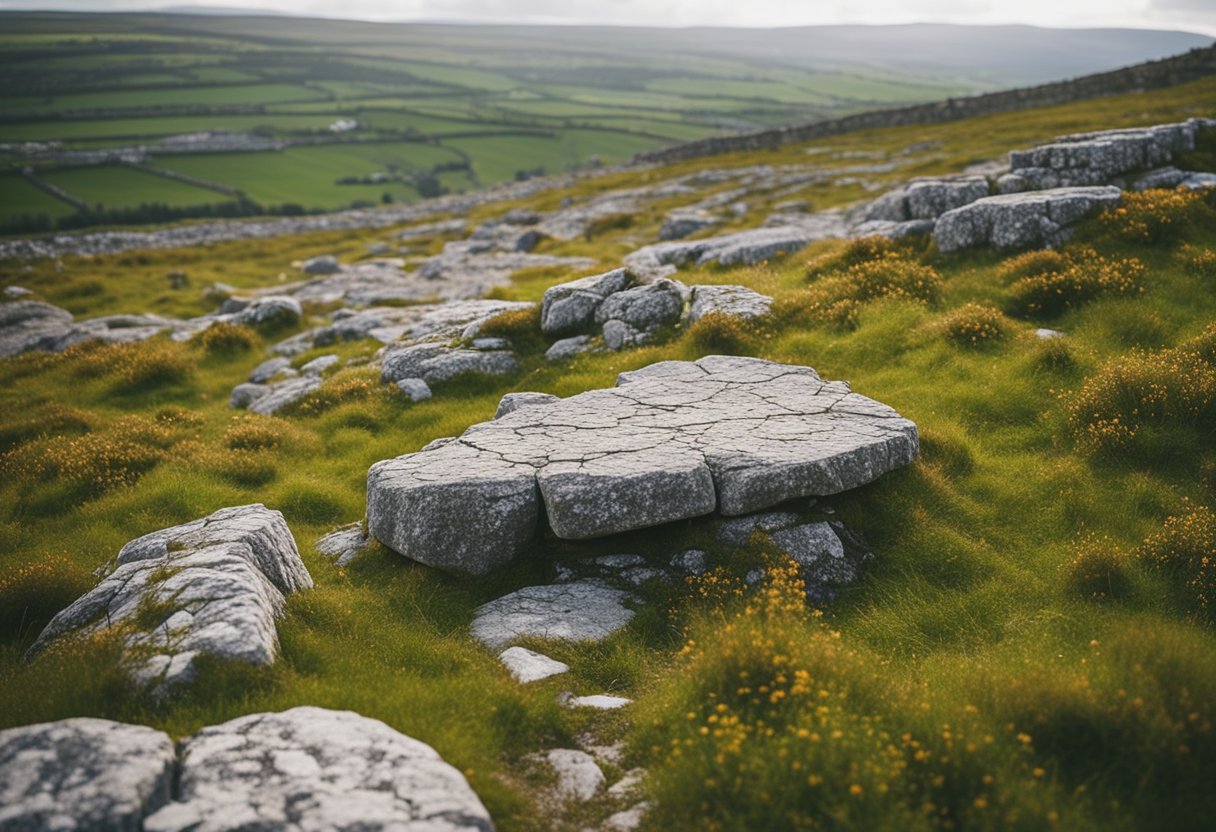
In addressing the unique landscape of The Burren, we’ve taken proactive steps to ensure its preservation for future generations. Our conservation efforts focus particularly on geo-conservation, which is vital in maintaining the integrity of this unparalleled Irish landscape.
Geo-Conservation
The Burren is recognised as a significant global geopark, underscoring its geological importance. As a UNESCO designated site, the Burren and Cliffs of Moher Geopark collaborates with local communities and stakeholders to conserve the area’s geological heritage. Our work in geo-conservation includes:
-
Monitoring of Biodiversity: The intricate ecosystems here are subject to continuous scientific monitoring to record any changes and to implement appropriate conservation strategies.
- Restoration of Dry Stone Walls: These iconic features of The Burren landscape are being restored using traditional methods, maintaining historical integrity and contributing to habitat conservation.
- Education and Awareness: We invest in educating visitors and locals alike about the importance of preserving this special area, ensuring an understanding of the significance of their actions.
- Management of Visitor Footfall: As a Special Area of Conservation, efforts are in place to balance tourism with conservation to prevent damage from increasing visitor numbers.
By undertaking these specific actions, we are committed to maintaining the geological, as well as the cultural, integrity of The Burren. Our dedication to preserving this irreplaceable landscape ensures that it remains a source of wonder and learning for many years to come.
Outdoor Activities
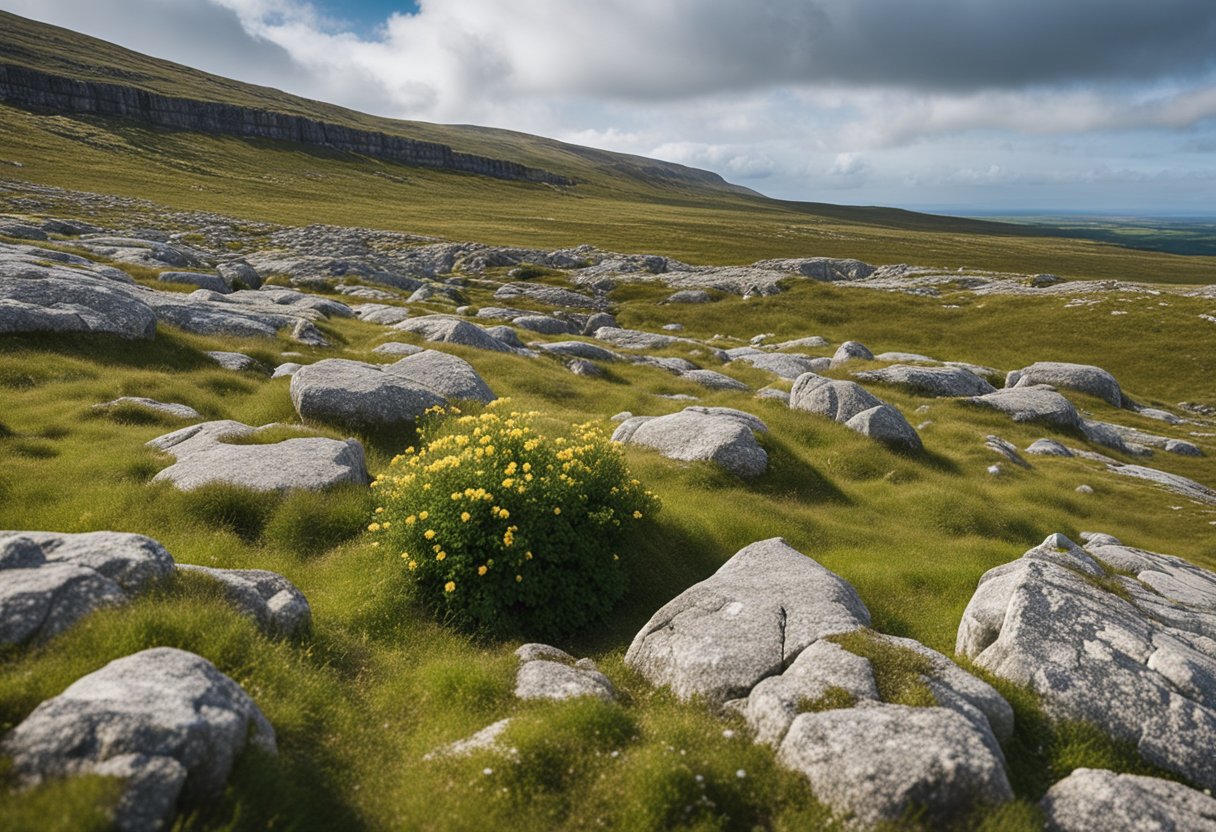
The Burren presents a remarkable outdoor playground for enthusiasts seeking more than just a scenic view. Our focus here is twofold: we guide you through the rugged trails preferred by walkers and hikers, and we uncover the thrills of adventure sports that are bound to elevate your adrenaline levels.
Walking and Hiking
The Burren Way is a haven for avid hikers. This marked walking trail carves its path through some of the most intriguing habitats in Ireland, offering an immersive experience into the region’s unique flora and fauna. The walk can be rigorous, but the vistas and geological formations are unmatched.
- Burren Way: A waymarked route offering a variety of terrains.
- Cliffs of Moher Coastal Walk: Experience breathtaking cliffside views on this iconic trail.
- Walking Trails: Numerous trails cater to casual walkers and seasoned hikers alike.
Adventure Sports
For those who fancy more exhilarating pursuits, the limestone landscapes morph into natural arenas for rock climbing. Ascending the Burren’s craggy edifices is both a physical and mental feat, providing a unique way to engage with this geological wonder.
- Rock Climbing: Tackle the Burren’s challenging rock faces.
- Tourism and Adventure: The Burren’s offerings contribute to a vibrant outdoor tourism sector.
Whether you’re tracing the serene expanses of the Burren Way or clinging to the ancient limestone on a rock climbing venture, the Burren’s outdoor activities are bound to leave you with lasting memories.
Burren in Economy

The Burren plays a significant role in the local economy, particularly through its speciality food products and robust tourism sector, both of which showcase the region’s rich cultural heritage.
Local Produce
In the heart of the Burren, economic activities are closely tied to its natural bounty. Unique flora and clean air contribute to the production of exceptional local honey and noteworthy artisan cheeses. The Burren Food Trail is a testament to the region’s commitment to sustainable food production, where visitors can experience the taste of the Burren through products like those from the Burren Smokehouse, renowned for its smoked salmon.
- Honey: Utilising the diverse range of wildflowers specific to the region.
- Cheese: Expertise in dairy produce yielding flavours distinct to the Burren’s environment.
- Burren Food Trail: A culinary journey connecting producers, restaurants, and educators passionate about the locale’s gastronomy.
Tourism Industry
Tourism stands as a pillar of the Burren’s economy. The lunar-like landscape draws visitors from around the globe, fuelling a multitude of associated economic activities. Our contributions include guided tours, heritage site visits, and outdoor activities — all centring around the appreciation of the Burren’s exceptional geology and folklore.
- Guided Tours: Guided walking tours offer insights into the geological wonder of the Burren.
- Heritage Sites: The region’s rich history is evidenced by megalithic tombs and historic ruins, enhancing its touristic appeal.
- Outdoor Activities: The Burren’s terrain allows for engaging activities such as rock climbing and caving, appealing to adventure travellers.
The Living Burren

The Burren is not just a captivating karst landscape; it’s also a living community where the past and present meet. The area is home to resilient towns and villages, each fostering a contemporary lifestyle that remains deeply connected to Irish culture.
Towns and Villages
Ennis, as the largest town nearby, serves as a vibrant hub for both locals and visitors, with its traditional Irish music scene and historic architecture. Ballyvaughan, a charming village, offers a glimpse into rural life beside the Burren, acting as a gateway for many to explore the region’s natural wonders. Other villages like Corofin and Tubber also contribute to the area’s lively community, hosting local markets and festivals that showcase the region’s rich heritage.
- Ennis: Bustling market town, cultural events, music.
- Ballyvaughan: Scenic views, local crafts, seafood.
- Corofin: Gateway to the Burren Heritage Centre.
- Tubber: Traditional charm, community spirit.
Modern Lifestyle
In these communities, the modern lifestyle is infused with tradition. Galway, a city known for its artistic legacy, lies within reach and influences the local culture with its vibrant arts scene. Here, we see an interplay between contemporary living and historic customs, where innovation coexists with tradition, and respect for nature is echoed in the community’s environmental practices. Today’s Residents maintain a quality of life enriched by the Burren’s distinct atmosphere and cultural expressions.
- Galway: Arts, innovation, cultural exchange.
- Lifestyle: Sustainable living, respect for heritage, community involvement.
The Burren’s towns and villages, including Ennis, Ballyvaughan, and beyond, offer a compelling narrative of life that thrives amid one of Ireland’s most extraordinary landscapes. Through the interactions and daily rhythms of these places, we find that the spirit of the Burren is very much alive and flourishing in the modern age.
Environmental Features
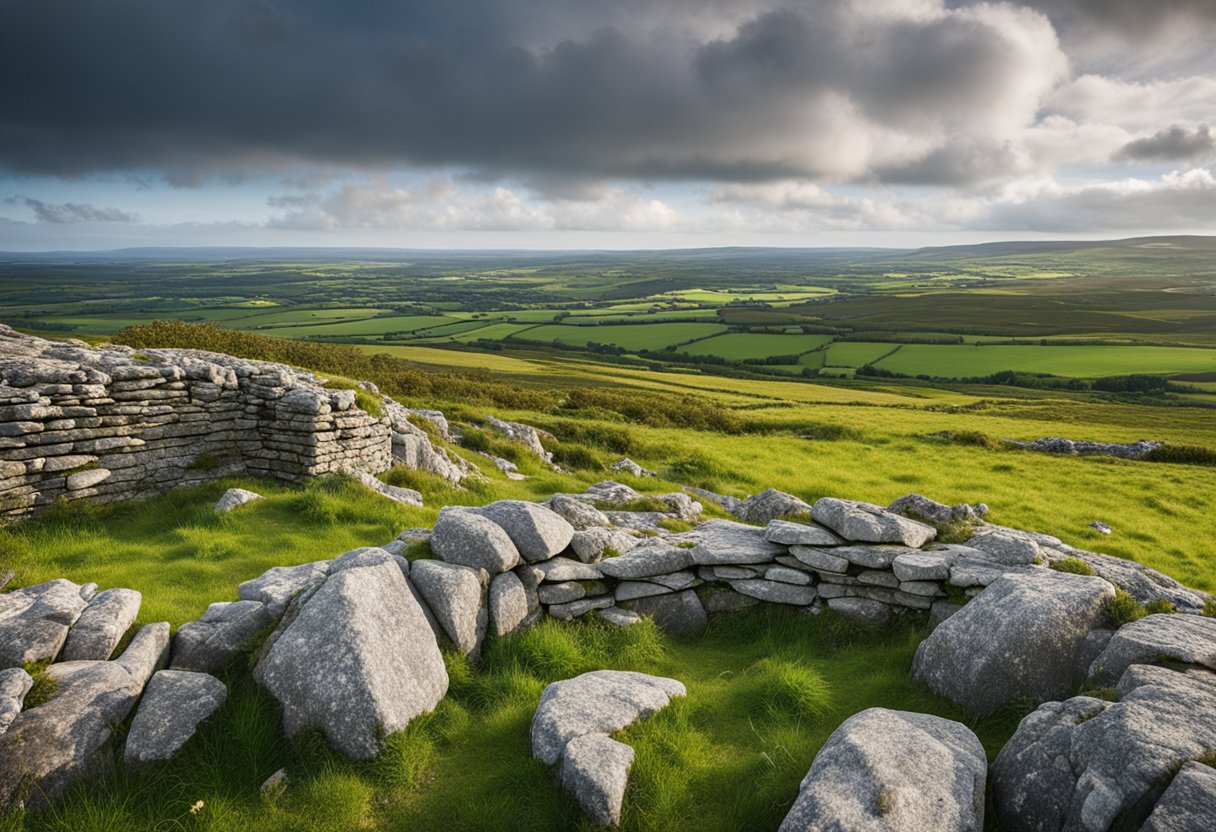
In our journey to understand The Burren’s unique environment, we discover a landscape carved by time and sculpted by elements. The limestone pavements of clints and grikes, the fluctuating presence of turloughs, and the delicate balance of its climate all play a crucial role in defining this otherworldly terrain.
Climate Influences
The Burren is characterised by its temperate oceanic climate, with influences that mould its striking topography. Average air temperatures hover around 15°C in July, dipping to a chillier 4-6°C in January. This climate underpins the existence of the Burren’s disappearing lakes, known locally as turloughs, which are seasonal features, appearing during wetter periods and vanishing during drier times.
Rainfall is another sculptor of The Burren’s environment, essential for forming and expanding grikes—deep fissures in the limestone. These grikes, alongside the clints—the blocks of limestone between them—create a distinctive puzzle-like pattern fundamental to the region’s unique biodiversity.
The Burren’s woodlands tuck into their sheltered niches, contrasting with the expansive lunar-like limestone landscape. Stratigraphy, or the layering of sedimentary rocks, tells the area’s ancient geological history, leaving clues to past climate fluctuations visible in the rocks underfoot.
With these features in our mind, we gain a deeper appreciation for The Burren—a mosaic of environmental elements shaped by a gentle yet persistent climate and the passage of countless seasons.
Frequently Asked Questions

In this section, we’re addressing some of the most commonly asked questions about The Burren, providing insights into its unique geological characteristics, cultural significance, biodiversity, and its impact on local communities.
What distinguishes the geological composition of the Burren from other limestone landscapes?
The Burren is notable for its extensive karst landscape, characterised by weathered limestone pavements with clints and grikes. Unlike other limestone areas, the Burren’s composition creates a lunar-like terrain, which supports a remarkable mix of Arctic, Alpine, and Mediterranean plant species coexisting in its unique ecosystem.
Can you identify the key reasons for Burren’s designation as a site of national significance?
As a site of national significance, the Burren is celebrated for its rich archaeological heritage, including megalithic tombs, ancient stone forts, and ecclesiastical sites. Its distinct geomorphology, archaeology, and ecology are the key reasons for its recognition, which include protected habitats for rare species and important research opportunities in glaciokarst systems.
What role does folklore play in the cultural heritage of the Burren region?
Folklore is deeply embedded in the cultural fabric of the Burren. The region boasts a wealth of myths, legends, and storytelling that have been passed down through generations. These tales and traditions reflect the historical significance and the mystical allure of Burren’s landscape, which has long been a source of inspiration and cultural continuity for the local community.
How does the Burren contribute to Ireland’s biodiversity and eco-tourism?
Burren’s unique geological structure has created diverse habitats contributing significantly to Ireland’s biodiversity. The area supports a variety of flora and fauna, including species that are rare or absent elsewhere in Ireland. This biodiversity is a key factor in driving eco-tourism, with visitors exploring its incredible karst landscape and discovering the thriving ecosystems within.
Could you outline the size of the Burren and its place within the Irish landscape?
Encompassing approximately 530 square kilometres, the Burren is situated in County Clare on Ireland’s west coast. The area is defined by the encircling villages of Lisdoonvarna, Corofin, Gort, and Kinvara. The Burren’s sizeable presence in the Irish landscape makes it a prominent feature that is distinguishable even from space due to its visible limestone pavement rock.
What are the visitor statistics for the Burren, and how does this impact the local economy and conservation efforts?
Visitor numbers to the Burren are a testament to its attraction, with tens of thousands of tourists experiencing the region annually. This influx of visitors significantly benefits the local economy through tourism revenues, leading to investment in local businesses and services. However, managing the balance between welcoming visitors and protecting the delicate karst landscape is crucial for sustainable tourism and conservation efforts in the area.


